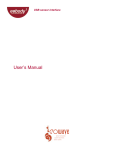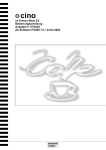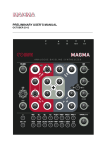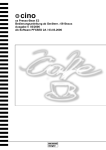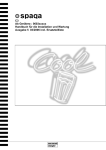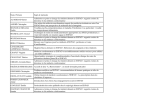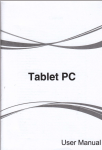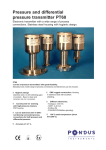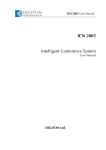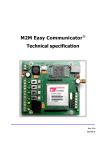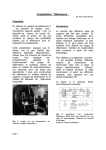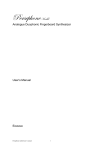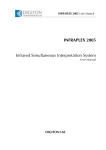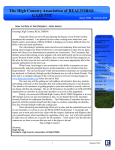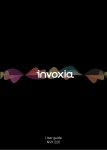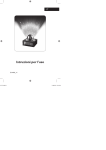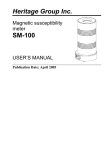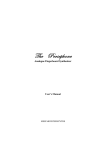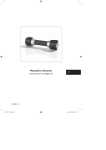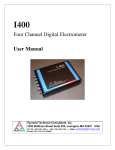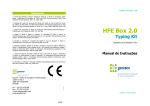Download Eobody1 user`s manual
Transcript
user’s manual 1.0 Safety instructions WARNING Before using eo•body, make sure you have read the following instructions carefully, as well as the instructions for use. • Do not open or modify eo•body or its main adapter. • Do not try to repair the interface or the components inside of it. Please contact eowave for technical support. • Do not use eo•body nor store it in the following conditions: - Extreme temperatures, or exposed to direct sunlight. - Damp areas. - Dusty areas. - Areas prone to strong vibrations. • If you replace the main adapter, make sure its output polarity, voltage and current are correct. • Do not insert any objects nor pour any liquid into eo•body. • Protect eo•body against violent shocks. • Before using eo•body in a foreign country, make sure the main adapter provided is compatible with the main supply. • If eo•body will not to be used for a long period, disconnect the adapter from the main. • Never place heavy objects on eo•body. • Never touch eo•body nor the adapter with wet hands when it is plugged in. • Before moving eo•body, make sure the main adapter and/or any external elements are disconnected from the unit. • Before cleaning eo•body, make sure the main adapter is not plugged. • During ligthning, unplug eo•body. All trademarks are property of their owners. user’s manual • Congratuations! - Unpacking Congratulations! We thank you for choosing eo•body, the essential link between the world of analogue sensors and the digital world of computer processing. The idea of this joint development between Ircam & eowave was to offer the most easy-to-use analogue to MIDI interface for an affordable price. Of course, other analogue to MIDI converters have already been developped in the past, but none have ever linked simplicity to quality and price like eo•body does. And indeed, the use of such tools has often been limited or been specially designed for big projects because of the high cost such installations usually require. eo•body interface is based on the analogue to MIDI converter Atomic Pro which has been developped by Emmanuel Flety Ph.D. & engineer at Ircam. With this high-end embedded technology, eo•body offers high quality data processing, including subsampling and internal filtering capabilities. This manual was written by Emmanuelle Gallin and proof read by Emmanuel Fléty eowave 7, rue Rouvet 75019 Paris - France tel.: +33/1 40 05 17 18 fax: +33/1 40 05 00 11 info@eowave.com sales@eowave.com www.eowave.com Ircam 1, place Igor-Stravinsky 75001 Paris - France tel: +33/1 44 78 49 62 fax: +33/1 44 78 43 55 admin-forum@ircam.fr Unpacking Your eo•body package should include the following items. Make sure everything is in the box. • eo•body • an AC/DC adapter 9 V/500 mA (European standard plug) • one pigtail cable D-SUB 15 to 8 Jack plugs 1/4“/ 6,35 mm • a CD containing: - the user’s manual - a free editor for Mac (OS9 and OSX) - examples of objects and patches for use within Max. • a registration card Write down the serial number of your eo•body for future reference! # manual ©eowave/Ircam 2003 3 Who’s Who • user’s manual Who’s Who Ircam Ircam was founded as a place that combines scientific research, development of related technologies and contemporary musical creation, for the benefit of the musical and scientific communities. One of the main goals is to contribute, through science and technology, to the renewal of musical expression. Reciprocally, specific problems related to contemporary creativity have lead to original steps in the scientific field, with theoretical, methodological and applied aspects. One of the main links between research and the musical production activities is done through the development of software environments for composition, that integrate models and prototypes which come from research teams working in various fields related to music: computer science (languages, human-computer interface, realtime, database management), digital signal processing, acoustics, psycho-acoustics and cognitive psychology of audition. Knowledge and tools are also applied to fields of activity in the industry that go far beyond contemporary musical production. « At Ircam, my work is mainly oriented towards the design of electronic hardware for stage and live performance applications. The aim of this design is to provide composer sand performers new tools for expression and control in order to communicate with the computers involved in computer assisted compositions and musical piece interpretation (sound processing, sound synthesis, sample triggering, spactialization…). One of those tools is AtoMIC Pro (Analogue to MIDI Converter). This device digitizes analogue signals from sensors to transmit them to the computer which might use those information as a «vision» of the outer world, so our five senses do. Thus stimulated, the machine can «answer» and take certain decisions depending on what happens on stage. This tool is very useful in the field of interactive sound and/or video installations where it is possibly needed, for instance, to detect a person at the key place in order to trigger a sound sample, or to measure the activity in a room to control the volume of a sound effect. » Emmanuel Fléty, Ircam. eowave « eowave was founded in 2002. Since 1998, we have designed our first products under the name of More Electronic Sounds. We have started with the development of software and stepped on hardware design of analogue machines and midi tools. There is not such a big gap between developing software and hardware: both are a subjective representation of the definition of the sound process. I really enjoyed developing iSynth. With the Essential Instruments from Cycling’74’s Pluggo 3, each module is dedicated to a special synthesis: granular, additive synthesis, FM, an analogue modeling synth or a wavetable synth… I have tried to extract the essential of synthesis, starting all over again with fundamental questions: «what’s an FM synthesis & how should it be concretized?» Now, some analogue effects I have designed - the little analogue effects called the «bugs» for example - can be viewed as some kinds of hardware Essential Instruments. Several little boxes, each representing an effect, a multimodal filter, a ring modulator, a phaser or a sequencer. Several little boxes any musician can use to add an analogue feeling to his music… Several easy-to-use little boxes which can be used alone or assembled to create new sounds. But aside the search for new tools, and new ways of expression is a real quest among unknown dimensions. The world of synthesis is immense, while the world of expression has no limits. At this frontier comes eo•body, an ideal intermediate between the external audio and video environment and the artist, the essentiel bridge linking the world of analogue sensors to the world of digital process. » Marc Sirguy, MESI/eowave CEO. 4 manual ©eowave/Ircam 2003 user’s manual • Table of contents Table of contents Safety instructions 2 Congratulations! & Unpacking 3 Who’s Who: 4 Ircam, eowave I - Sensors & new ways of expressions 6 II - General Overview 8 Description (Front view, Rear view) 9 III - First steps Power eo•body, Connect a sensor to eo•body, Basic Configuration, Connect eo•body to your computer, Use two eo•body or more, Reset eo•body to factory settings IV - Use eo•body editor 12 Install eo•body editor, eo•body editor menus, first step with eo•body editor, eo•body editor Window, eo•body Input windows1-8 & 9-16, (Status, Resolution, Zoom & Offset, Type (Control change / CC, Note on message / N-ON trigger, Program change / PC, Pitch bend / PB, Polyphonic Aftertouch / Atp, Monophonic Aftertouch / Atm), Channel, Gate , S Samp Val 1, Prm1, Prm2), Configuration map for analogue inputs, Knobs & Switches Window (Type, Channel, Value), Configuration example Appendices 1 - Maximal Voltage Range for global scaling 21 2 - Example of a Sysex configuration of an eo•body preset 22 3 - Making my own sensors 24 Making my own sensor switch, Making my own sensor potentiometer, Making my own sensor with other kinds of sensors, Analogue Input Connections (D-SUB 15 Wiring, Jack 1/4“ - 6,35 mm, Jack plug 1/4“ - 6,35 mm) 4 - List of MIDI Controllers 26 5 - MIDI Implementation Chart 27 Technical specifications 28 eo•body Development Team, Thanks, Contacts & support 29 manual ©eowave/Ircam 2003 5 I - Sensors & new ways of expression • user’s manual I - Sensors & new ways of expression From the Idea… Men have always dreamt of new ways of communication. Through ages, men have thought of their body as a tool of communication. And indeed, when communicating, this is not only your voice, nor the only expression in your face that transmits a message, but your entire way of being. This is your entire body which projects you inside the individual world of one another. In all cultures, men have developped new ways of communication through dance, music, art. And still in a matter of a better communication, men have always worked to improve the interaction between men and machines, thus since the very beginning of mechanics and later, electronics. More and more, the body has become the cornerstone of interactive systems of communication. New technologies widen the range of controls. And controls have entered everyday’s life without us noticing. Remote controls are everywhere: we control TV, we control VCRs, DVDs, stereos, ovens, climates, windows, garage doors… Control surfaces are everywhere. Faced to art, control appears to be the new way of expression of this early millenium. Many artists are looking for new ways of expression, of conceptualizing ideas… In this perspective, sensors open new dimensions of expression. eo•body is the key link between the world of analogue sensors and digital systems. …To the Realization The need of new technologies to control the sound has increased with the development of interactive sound installations and interpretation of musical pieces requiring interfaces other than traditional instruments. eo•body is the intermediate you need to connect sensors of any kind (faders, mechanical pressure sensors, piezo electric sensors, infrared barriers, intruder detector/passive IR sensors, temperature sensors, etc.) to a musical MIDI environment (sequencer, computer, sampler…). eo•body does not impose the sensor type and features portability and versatility. It can be used for sound synthesis control with the jMax environment (Real time team), PD or Max/MSP. As another example, eo•body can also be used for the control of a MIDI/digital audio sequencer with an original and completely new user interface. The MIDI digital code allows to transmit many different data sources. It is known for the transmission of music notes but other sources such as light, pressure, temperature, speed or electromagnetic field can be transcoded via MIDI. Considering this, the field of applications of MIDI becomes much wider… All you need is a powerful analogue to MIDI converter like eo•body and sensors of your choice. As a sensors to MIDI interface meaning to simplify the design of new gestural controllers or interactive sensor-based sound installations, eo•body converts analogue signals generated by sensors to MIDI messages which will be received by a sound generator and used to control parameters such as volume, panoramic, reverberation… The MIDI messages coding the gestures act directly on the sound, turning the whole system into a new kind of musical instrument. eo•body will transmit the sensors signal to the computer under digital form, through the MIDI standard. eo•body is fully compatible with any kind of devices featuring a MIDI interface (MIDI port) and makes a real bridge between the analogue world of sensors and digital audio control by gestures. Don’t limit yourself: eo•body can convert to MIDI up to 16 sensors! 6 manual ©eowave/Ircam 2003 user’s manual • I - Sensors & new ways of expression Internal process MIDI input Analogue inputs Parameters Non volatile memory Multiplexer 10 bit A/D converter 7 bit conversion MIDI message MIDI ouput 10 bit SYSEX message manual ©eowave/Ircam 2003 7 • II. General overview user’s manual II - General Overview Front view a b f a b c d e f g h i j k l m c f Powerplug status LED: MIDI out LED: MIDI in LED: [1-8]: [9-16]: Buttons A, B, C, D: Potentiometers 1, 2, 3: Inputs [1-8]: Inputs [9-16]: Maximal voltage: MIDI in: MIDI out: 9V DC power plug d g e g g f f lights up when plugged & when receiving valid SysEx data lights up when sending MIDI messages lights up when receiving MIDI messages serigraphy for inputs 1 to 8 serigraphy for inputs 9 to 16 free assignable MIDI buttons free assignable MIDI potentiometers D-Sub connector 1 for the inputs 1 to 8 D-Sub connector 2 for the inputs 9 to 16 trimmer to set the maximal voltage range (see Appendix 1) MIDI in plug for receiving SysEx data from a computer MIDI out plug for sending MIDI data to your remote device to be connected to the 9 V/500 mA power supply (European standard plug) Rear view h 8 manual ©eowave/Ircam 2003 i j k l m user’s manual • III - First steps III - First steps III.1. Power eo•body Connect a 9 V DC / 500 mA power plug into the power plug connector of eo•body. The red LED lights up when eo•body is well connected. An internal fuse is activated when not plugged right. 220V or 110 AC / 9V DC adapter Mains 220V - 110V AC 9V DC - III.2. + Connect a sensor to eo•body female 1/4“ jack to connect to the sensors D-SUB 15 pigtail cable To be connected to eo•body input 1-8 or 9-16 A pigtail D-sub cable is delivered with eo•body. The D-SUB connector may be plug either on the female D-SUB connector 1 for the inputs 1 to 8 or to the female D-Sub connector 2 for the inputs 9 to 16. Each of the 8 female 1/4’’ jacks from the pigtail cable may be connected to male 1/4’’ jack cable from a sensor. Additional pigtails are available thru eowave. manual ©eowave/Ircam 2003 9 • III.3. - First steps III.3. user’s manual Basic Configuration Basic configuration to control a MIDI expander with eo•body Plug the eo•body MIDI out to the MIDI expander MIDI in. MIDI cable MIDI expander MIDI in Audio amplifier MIDI out Mixing desk Sensors III.4. Connect eo•body to your computer To connect eo•body to your computer, plug the eo•body MIDI out to the MIDI interface MIDI in from your computer. Plug the eo•body MIDI in to the MIDI interface MIDI out from your computer. computer with eo•body editor MIDI interface and other audio software MIDI cables analogue signal USB, serial or sound card with MIDI port SENSOR 10 manual ©eowave/Ircam 2003 USB, Firewire or internal soundcard audio signal user’s manual III.5. • III.5. - First steps Use two eo•body or more When using two eo•body, these units should be connected in parallel to the MIDI interface. It means that the MIDI interface requires 2 MIDI IN and 2 MIDI OUT ports. eo•body has no merging function. Therefore, two units cannot be connected in serial (but both eo•body on a unique MIDI IN and OUT using a MIDI merger). If you need more than 2 eo•body, use as many different MIDI ports as the number of eo•body units. Our choice not to use merging capabilities was determined by our will to keep a 100% accurate data flow. Unfortunately, MIDI merging may be the source for losing informations provoking undesirable treatment delays. When using two MIDI ports, the delay generated will always be equal to the use of 16 active inputs, thus with 32 or more active inputs. The computer will merge data without losing information nor generating additional delays. MIDI cables MIDI interface MIDI port 1 computer with eo•body editor and other audio software SENSOR MIDI port 2 USB, serial or sound card with MIDI ports SENSOR analogue signal III.6. Reset eo•body to the factory settings Should the eo•body need a factory reset, follow these instructions: - On powering up the eo•body, press the A & B buttons. > the red LED should flicker. - Press now the D button. > The red LED should flicker faster. - Power down the eo•body. > The eo•body is reset to factory setting (i.e. controlers 1 to 7 on channel 1). manual ©eowave/Ircam 2003 11 IV. - Use eo•body Editor • user’s manual IV - Use eo•body editor IV.1. Install eo•body editor For Mac only For now, eo•body editor is a Macintosh application only. A PC version will be developped in the nearest future. Installation For MacOS 9, you need OMS 2.3.8 installed in your computer. Insert the eo•body CD delivered in the CD player from your computer. Move the eo•body folder on your hard disc. It contains one stand-alone application. Double-click on the icon to open it. For Maxers If you are a Max/MSP user, you may use the collective file to avoid two Max applications running on the same computer. IV.2. eo•body editor menus File Menu Open, Save, Save as : opens, save and save as eo•body presets. Presets can be stored. They may be recall for a specific configuration. MIDI Setup : Open the MIDI configuration setup. Function Menu Dump : Send a preset to eo•body Request : Request a preset from eo•body Inputs 1-8 : Open configuration window Inputs 9-16 : Open configuration window Switchs & knobs : Open switches & potentiometers configuration window 12 manual ©eowave/Ircam 2003 user’s manual IV.3. • IV.3. - Use eo•body Editor First step with eo•body editor When opening eo•body editor window, no parameters are set. To modify the configuration from eo•body, you may first transfer its memory into the editor or recall a preset configuration already stored on your hard drive. To proceed to this transfer, you need a bi-directional MIDI connection with the MIDI out from your computer connected to the MIDI in from eo•body & the MIDI out from eo•body connected to the MIDI in from the computer. Ensure that you are using the same port on eo•body. The «request» button from the editor enables to send a message to eo•body to dump eo•body ’s memory. eo•body ’s memory contains will be dumped and its information will be displayed on the 1-8 Inputs Window, 9-16 Inputs Window or Knobs & Switches Window. You may proceed to the modification from your configuration in two steps : First, modify the parameters from your configuration directly on the editor. Secondly, dump your new configuration into eo•body. Once the modifications are stored, you may test your configuration with the Input Monitor Window from the eo•body editor : each bargraph shows the activity from each input. Note : 10 bits data are not represented by the Input Monitor Window. Once tested, unplug eo•body ’s connection from the computer. eo•body has a non-volatile memory. You may also store your configurations onto your hard drive & recall them when desired. manual ©eowave/Ircam 2003 13 IV.4. - Use eo•body Editor IV.4. • user’s manual eo•body editor window Main editor window Dump file to eo•body’s memory Select MIDI port (MIDI in and out must be on the same port) Request a file from eo•body’s memory Open the configuration window for analogue inputs 9 to 16 Open the configuration window for analogue inputs 1 to 8 Open the configuration window for switches and potentiometers Information about activity of the 16 analogue inputs Information about type of controller coming in patch name The main editor window offers one pop-up menu and 5 buttons: dump, request, 1-8, 9-16 and knobs. 14 midi port menu enables to choose the transmission and reception port. Transmission and reception port has to be the same. dump dump a configuration/set up to eo•body request request the current configuration/set up from eo•body 1-8 opens the configuration window for inputs [1-8] 9-16 opens the configuration window for inputs [9-16] knobs opens the configuration window «knobs & switches» for the setting of the 4 switches and the 3 potentiometers from the front panel of eo•body. Input monitor gives information of what’s coming in. 16 bars represent the data which are being sent from analogue inputs. More accurate information will also appear on the last line from the window. Patch name shows the name of the patch. manual ©eowave/Ircam 2003 user’s manual • IV.5. - Use eo•body Editor eo•body input windows 1-8 & 9-16 IV.5. The whole IV.5. part applies to both input windows 1-8 and 9-16, substitute inputs 9-16 to 1-8 where necessary. Resolution Offset Channel Zoom Type Status Gate Sub sampling Parameter 1 Value 1 Parameter 2 With this window, you may set the inputs 1 to 8 from eo•body. Inputs 1 to 8 use a D-SUB connector. Status The status field indicates whether the signal on an analogue input should be converted into a MIDI message or not. This field may be set to ON or OFF. If the field is set to OFF, the input is said to be inactive and no MIDI message relating to that input will be generated, even if a signal does physically enter the device. If the field is switched back to ON, the input is active and its associated MIDI message will be sent each time the signal connected to that input varies in level. on/off Note: The smaller the number of active inputs is, the higher the acquisition frequency of the active inputs will be. Resolution Sets the resolution for sent data. 7 bits generates information from 0 to 127. This information format is used by most common hardware & software MIDI devices. 10 bits generates information from 0 to 1023. This is a more accurate format but can only be used to send pitch bend or CC data with MSB/LSB (Most Significant Bits/Least Significant Bits). MSB/LSB can only be used with softwares like Max/MSP, Jmax or PD. Note about the high resolution: • For the pitch bend message, the 10 bits of the sampled value are mapped on the ten most significant bits of the MIDI message which actually counts 14 bits. • For the control change message, the 3 Most Significant Bits (MSB) are sent via the Prm1 controller number whilst the «normal» controller number exports the 7 Least Significant Bits (LSB). To obtain the 10 bit value, the following calculation must be computed: 10 bit value = (MSB controller value X 128) + LSB controller value. A Max/PD Abstraction is avalaible on the CD. See «Combine Ctr». manual ©eowave/Ircam 2003 15 • IV.5. - Use eo•body Editor Zoom & Offset user’s manual Those two parameters specify how the real range of an analogue input can be mapped on a seven bit MIDI value. As a matter of fact, a sensor does not necessarily have a range equal to the reference voltage of the Analogue to Digital Converter. We have implemented a custom scaled zoom on the digital value to take advantage of the 10 bit resolution of the A/D converter. First, the voltage reference has to be set to the largest range among the sensors connected to the unit. Then, the user can select the sensor’s range within the 10 bits dynamic by specifying a window size and an offset. The selected range can then be converted into 7 bits MIDI data without greatly increasing the quantification step, as shown in the following illustration. Zoom: max/mid/low/off Offset: 0 to 895 (depending on zoom level) Digital value (10 bits) MIDI data (7 bits) 1023 MIDI conversion zoom setting = real sensor range 127 Offset 0 Type This is one of the most important configuration parameters, since it determines which type of MIDI message the device is going to send in response to variations in a particular analogue input. eo•body is capable of generating 6 different messages: • • • • • • Control Change CC 16 manual ©eowave/Ircam 2003 CC: Note: PC: PB: ATp: ATm: Control number change (Control change) Note on Trigger Program change Pitch bend (Variation in pitch) Polyphonic aftertouch (Polyphonic pressure) Monophonic aftertouch (Channel pressure) This is the type of message which will likely be most often used for controlling sound parameters. The value of the analogue signal acts directly upon the value of a MIDI controller, using a MIDI controller Value Change message (control change). The number of the controller can be set by the user. If 10 bits resolution is selected, this message will actually send two Control Change messages. The controller specified in the val field will send the 7 least significant bits whilst the controller specified in the prm1 field will send the 3 most significant bits, on the same MIDI channel. user’s manual • IV.5. - Use eo•body Editor Note on message The analogue signal must correspond to an envelope changing with time and which has a maximum value. You will have to specify 3 parameters, note sent, higher treshhold, lower treshhold. eo•body analyses this envelope: once the envelope has reached the higher treshhold, a MIDI note on message (NOTE ON) is generated. The velocity associated with the note is fixed to 127. The note number contained within the message is adjustable by the user. As long as the envelope stays above a threshold, named NOTE OFF threshold, the note is maintained (no new MIDI message is sent). When the level falls beneath the NOTE OFF threshold, a MIDI NOTE OFF message is sent to turn the note off. To sustain the note for a long period of time, you just need to give a small value to the NOTE OFF threshold. Conversely, to make the note stop shortly after the peak has been detected, you need to set the NOTE OFF value quite large. This type of message is useful in using sensors to generate MIDI notes. N-ON trigger Signal NOTE ON message NOTE ON threshold NOTE OFF message NOTE OFF threshold t NOTE ON t NOTE OFF t Program Change message PC Pitch bend PB The analogue signal must correspond to an envelope changing with time and which has a maximum value. You will have to specify 3 parameters, Program Change sent, higher treshhold, lower treshold. eo•body analyses this envelope: once the envelope has reached the higher threshold, a MIDI Program Change message is generated. The Program Change contained within the message is adjustable by the user. As long as the envelope stays above a threshold, named lower threshold, the Program Change is maintained (no new MIDI message is sent). When the level falls beneath the lower threshold, the eo•body is ready to receive a new Program Change message. This message allows an analogue signal to generate a MIDI message of the pitch change type (pitch bend). Pitch is usually coded over 14 bits. If the 7 bits resolution is chosen, they will be mapped on the 7 most significant bits of pitch information controlled by the analogue signal. However, since eo•body does 10 bits conversions internally, the whole 10 bits can be mapped to take better advantage of the pitch bend message. This message is used to simulate the pitch changing wheels available on most MIDI keyboards. Polyphonic Aftertouch ATp This message allows an analogue signal to generate a polyphonic pressure type MIDI message (polyphonic aftertouch). The number of the note to which the pressure information is applied can be changed by the user. manual ©eowave/Ircam 2003 17 • IV.5. - Use eo•body Editor user’s manual Monophonic Aftertouch This message allows an analogue signal to generate a channel pressure type MIDI message (channel aftertouch). This pressure message affects a whole MIDI channel, regardless of what note is played. The channel number to which the pressure information is applied is selected by the user. ATm Channel This field enables the user to select a MIDI channel to which the MIDI message will apply (1 to 16). MDI Channel: [1-16] Gate The noise gate threshold specifies the variation of the analogue signal that would be detected as a change. If the analogue signal moves inside the range of the noise gate, no MIDI message will be sent. This field enables the user to set the width of the range. A large range will be very effective against strong noise but will make the MIDI value less sensitive to a relevant change of the analogue signal. For a reference voltage of +5V a threshold of 8 corresponds to a noise level of ± 40 mV (ie: the analogue has to change at least of 40 mV above or under its current position to be detected as changing). A threshold of 127 corresponds to a ribbon of ± 620 mV of noise. Noise Gate: [0-127] Sensor Noise band Sensor signal 2* (noise) 0 S Samp subsamp Val 1 val: 0 - 127 18 manual ©eowave/Ircam 2003 Sampled value Sampled value +MIDI message t This field enables the user to adjust the subsampling filter. SUBSAMP is a subsampling filter (also called downsampling filter). It will make eo•body analyse the analogue input not every scan cycle. Thus, fast changes on the signal will not be detected resulting a lowpass filter. The number of «wasted cycles» is configured in the Nb Cycles field. This field enables the user to set the fixed parameter of a MIDI message associated with an analogue input. This parameter value may correspond to a MIDI note number, a MIDI controller number or a MIDI program number, depending on the type of MIDI message which is chosen. user’s manual Prm1 • IV.6. - Knobs and Switches window This field enables the user to configure the note on activation level for trigger messages or for the MSB controller number. multipurpose parameter #1 0 - 127 Prm2 Same as Prm 1, depending on what type of MIDI information are sent. multipurpose parameter #2 0 - 127 Configuration map for analogue inputs Type of message Res. Val1 Prm1 Prm2 CC - Control Change 7 bits CC value CC - Control Change 10 bits CC MSB CC LSB Note - Note on trigger 7 bits note number higher threshold lower threshold PC - Program Change 7 bits PG value higher threshold lower threshold PB - Pitch Bend 7 bits PB - Pitch Bend 10 bits ATp - polyphonic aftertouch 7 bits ATm - monophonic aftertouch 7 bits IV.6. note number Knobs & Switches Window Enables to set the 4 switches and the 3 potentiometers from the front panel of eo•body. Note that switches and potentiometers do not transmit the same kind of information. Switches transmit Control Change messages, Note On, Note Off, Pogram Changes. Potentiometers transmit Control Change messages, Pitch Bend, Polyphonic Aftertouch, Monophonic Aftertouch. manual ©eowave/Ircam 2003 19 IV.7. - Configuration example Type • user’s manual This is one of the most important configuration parameters, since it determines which type of MIDI message the device is going to send in response to variations in a particular analogue input. eo•body is capable of generating the messages as follow. Applicable to switches: • CC: Control number change (Control change) • Note: Note on Trigger • PC: Program change Applicable to potentiometers: • • • • CC: PB: ATp: ATm: Control number change (Control change) Pitch bend (Variation in pitch) Polyphonic aftertouch (Polyphonic pressure) Monophonic aftertouch (Channel pressure) For the description of these parameters, see the IV.2 eo•body input windows 1-8 & 9-16 section. Channel This field enables the user to select a MIDI channel to which the MIDI message will apply (1 to 16). Ch: [1-16] Value Val: 0-127 IV.7. This field enables the user to set the fixed parameter of a MIDI message associated with an analogue input. This parameter value may correspond to a MIDI note number, a MIDI controller number or a MIDI program number, depending on the type of MIDI message which is chosen. Configuration example To set Controller #1 on channel 1 from eo•body using input 1, with a pedal for example. 1. 2. 3. 4. 5. 6. 7. 8. 9. 10. 11. 12. 13. 14. 15. 20 Connect eo•body to your computer Open eo•body Editor, press the «request» button from the editor, open 1-8 Inputs Window & configure input 1 parameters Set status on Select 7 bit Set zoom off - offset will be automatically disactivated Select type CC Select channel 1 Open gate on 8 Set subsampling on 0 Set val1 to 1 Prm1 & Prm2 are not used in this configuration DUMP Plug the 1/4’’ jack from the foot pedal into the female 1/4’’ jack from the channel 1 of the pigtail cable. Start playing with the foot pedal. The green bargraph from the main editor window should follow your moves. The sensor (foot pedal) is now ready to be used within other applications. Once set so, you don’t need the eo•body editor anymore. You may unplug eo•body from your computer. manual ©eowave/Ircam 2003 user’s manual • Appendix 1 / Maximal voltage range Appendices 1 - Maximal Voltage Range for global scaling The trimmer position enables to set the maximal analogue voltage before conversion to digital. It means that analogue signal from 0 to 5 Volts will be converted into digital values from 0 to 1024. Some sensors may have a range from 0 to 4 Volts. To get the maximal digital range, the trimmer should be adjusted to 4 Volts. Note that voltage references value below 2.5V may increase sensitivity to noise. Analogue signal Digital value 5V 1023 2,5V 512 Range 0 t Signal 1 Signal 2 When the Maximal Voltage Range is set under the maximal voltage from the sensor, the signal may clip and some information may be lost. Always ensure that the reference voltage is set to the maximum range of the connected sensors. Reference voltage Digital value Dead areas 1023 5V 3V maximum range of the signals 0 Analogue signals manual ©eowave/Ircam 2003 21 • Appendix 2 / SYSEX user’s manual 2 - Example of a Sysex configuration of an eo•body preset The whole sysex file has to be sent at one time To modify parameters, values from row 3 for the switches, from row 4 for the potentiometers, from row 6 to 23 for imputs 1 to 16 need to be adjusted. 0, 1, 2, 3, 4, 5, 6, 7, 8, 9, 10, 11, 12, 13, 14, 15, 16, 17, 18, 19, 20, 21, 22, ‘eoprogram ‘; 240 0 32 57 64 127; 0 8 0 0; 1 0 1 0 1 0 2 0 1 0 3 0 1 0 4 0; 1 0 5 0 1 0 6 0 1 0 7 0; 0 0; 0 0 8 0 0 8 1 0 0 0 0 0 3 0 0 0 0 0; 0 0 8 0 0 8 2 0 0 0 0 0 3 0 0 0 0 0; 0 0 8 0 0 8 3 0 0 0 0 0 3 0 0 0 0 0; 0 0 8 0 0 8 4 0 0 0 0 0 3 0 0 0 0 0; 0 0 8 0 0 8 5 0 0 0 0 0 3 0 0 0 0 0; 0 0 8 0 0 8 6 0 0 0 0 0 3 0 0 0 0 0; 0 0 8 0 0 8 7 0 0 0 0 0 3 0 0 0 0 0; 0 0 8 0 0 8 8 0 0 0 0 0 3 0 0 0 0 0; 0 0 8 0 0 8 9 0 0 0 0 0 3 0 0 0 0 0; 0 0 8 0 0 8 10 0 0 0 0 0 3 0 0 0 0 0; 0 0 8 0 0 8 11 0 0 0 0 0 3 0 0 0 0 0; 0 0 8 0 0 8 12 0 0 0 0 0 3 0 0 0 0 0; 0 0 8 0 0 8 13 0 0 0 0 0 3 0 0 0 0 0; 0 0 8 0 0 8 14 0 0 0 0 0 3 0 0 0 0 0; 0 0 8 0 0 8 15 0 0 0 0 0 3 0 0 0 0 0; 0 0 8 0 0 8 0 1 0 0 0 0 3 0 0 0 0 0; 247; program name (for internal use of the editor only) header tag (not to be changed) empty informations for further use switch configuration potentiometer configuration empty informations for further use (not to be changed) input 1 configuration input 2 configuration input 3 configuration input 4 configuration input 5 configuration input 6 configuration input 7 configuration input 8 configuration input 9 configuration input 10 configuration input 11 configuration input 12 configuration input 13 configuration input 14 configuration input 15 configuration input 16 configuration Footer tag (not to be changed) Switches and potentiometers use the same parameters Switch configuration 4 x 2 bytes for switches A, B, C, D Potentiometer configuration 3 x 2 bytes for potentiometers 1, 2, 3 channel C (0-15, type of information X (0-5), value 0 0 (0-127, in 8 bits on 2 bytes) CX00 Example: Controller 1 on Channel 1: 0 0 1 0 Controller 64 on Channel 16: 15 0 0 4 Type of information 0 1 2 3 4 5 CC Note On Trigger Program Change Picht Bend Polyphonic After Touch Monophonic After Touch An entire sequence for pots will be Example CC 1 to 3 on Channel 1 4, 0 0 1 0 0 0 2 0 0 0 3 0; 22 manual ©eowave/Ircam 2003 user’s manual • Appendix 2 / SYSEX Configuration of inputs 1 to 16 is the same for each input 6, 0 0 8 0 0 8 1 0 0 0 0 0 3 0 0 0 0 0 example of input 1 status ON, 7 resolution, zoom off, offset O, type CC, Channel 1, Gate 8, Subsamp 0, Val1 1, Prm 1 0, Prm2 0 All parameters in 8 bit format on 2 bytes except for the offset in 14 bits on two 8 bits values (MSB/LSB) Note: some 1 2 3 4 5 6 7 8 9 parameters are coded on the same bit 00 subsampling 00 gate + resolution (gate + 128 for 10 bits, gate + 0 for 7 bits) 0 MIDI Channel 0 Type of controller +status ON/OFF (Type + 8 for ON, Type + 0 for OFF) 00 Value 1 (0-127) 00 Prm 1 (0-127) 00 Prm 2 (0-127) 00 Zooming (0-3) - (0 is max, 3 is off) 0 0 0 0 offset in 14 bits only the first 10 bits are used A code which is directly sent to eo•body will be like: 240 0 32 57 64 127 0 8 0 0 15 0 0 4 0 0 2 0 1 0 3 0 1 0 4 0 0 0 1 0 0 0 200030000080081000003000000080082000 003000000080083000003000000080084000 003000000080085000003000000080086000 003000000080087000003000000080088000 0 0 3 0 0 0 0 0 0 0 8 0 0 8 9 0 0 0 0 0 3 0 0 0 0 0 0 0 8 0 0 8 10 0 0 0 0 0 3 0 0 0 0 0 0 0 8 0 0 8 11 0 0 0 0 0 3 0 0 0 0 0 0 0 8 0 0 8 12 0 0 0 0 0 3 0 0 0 0 0 0 0 8 0 0 8 13 0 0 0 0 0 3 0 0 0 0 0 0 0 8 0 0 8 14 0 0 0 0 0 3 0 0 0 0 0 0 0 8 0 0 8 15 0 0 0 0 0 3 0 0 0 0 0 0 0 8 0 0 8 0 1 0 0 0 0 3 0 0 0 0 0 247 manual ©eowave/Ircam 2003 23 • Appendix 3 / Making your own sensors user’s manual 3 - Making my own sensors eo•body supports many kind of sensors. Most common sensors are switches and potentiometers, but there are many other kinds of sensors. Making my own sensor switch Switch 3-5 Kohm ground + 5V (to avoid antenna effect when the switch is off) Signal Sensors need a minimum of two cables: ground and signal. When 5 V is connected to the signal - when using switches for example - it may create an antenna effect generating undesirabled distorsion. This is the reason why the signal must be connected to the ground. Making my own sensor potentiometer Potentiometer + 5V ground Signal To use a standard potentiometer with eo•body, connect both outputs of the potentiometer resistor to the ground and 5 V. Connect the variable output of the potentiometer to the signal input. Making my own sensor with other kinds of sensors Coming from eo•body or external power supply (any other voltage has to come from an external power supply) + 5V or + 9V Sensor ground ground Signal Some sensors like distance sensors need an extra power supply. eo•body delivers +5V and +9V to power these sensors up to 250 mA. When the total consumption from all the sensors plugged to eo•body is higher than 250 mA, an additional external power supply is necessary. 24 manual ©eowave/Ircam 2003 user’s manual • Appendix 3 / Making your own sensors Some sensors have a weak signal out and need amplifying. To avoid undesirable noises, the amplifier should be placed as close as possible from the sensor. Connection cable NOISE Sensor eo•body amplifier GOOD d1 d2 Connection cable NOISE Sensor eo•body amplifier BAD d1 d2 d1<<d2 Analogue Input Connections D-SUB 15 Wiring 1. 2. 3. 4. 5. 6. 7. 8. signal signal signal signal signal signal signal signal 1 2 3 4 5 6 7 8 9. 10. 11. 12. 13. 14. 15. gnd gnd gnd gnd +5V +5V +9V 8 7 6 5 4 3 2 1 pin 15 pin 1 +9V +5V Ground Jack 1/4“ - 6,35 mm ground +5V signal Jack plug 1/4“ - 6,35 mm Tip: +5V Ring: signal Sleeve: ground manual ©eowave/Ircam 2003 25 • AppendiX user’s manual 4 - List of MIDI Controllers N° Function 0 1 2 3 4 5 6 7 Bank Select 0-127 MSB Modulation wheel 0-127 MSB Breath control 0-127 MSB Undefined 0-127 MSB Foot controller 0-127 MSB Portamento time 0-127 MSB Data Entry 0-127 MSB Channel Volume 0-127 MSB (formerly Main Volume) Balance 0-127 MSB Undefined 0-127 MSB Pan 0-127 MSB Expression Controller 0-127 MSB Effect control 0-127 MSB Effect control 0-127 MSB Undefined 0-127 MSB Undefined 0-127 MSB General Purpose 0-127 MSB Controler Undefined 0-127 MSB Bank Select 0-127 LSB Modulation 0-127 LSB Breath control 0-127 LSB Undefined 0-127 LSB Foot controller 0-127 LSB Portamento time 0-127 LSB Data entry 0-127 LSB Channel Volume 0-127 LSB (formerly Main Volume) Balance 0-127 LSB Undefined 0-127 LSB Pan 0-127 LSB Expression Controller 0-127 LSB Effect control 1 0-127 LSB Effect control 2 0-127 LSB Undefined 0-127 LSB Undefined 0-127 LSB General Purpose 0-127 LSB Controller (1-4) Undefined 0-127 LSB Damper pedal ≤63=off ≥64=on on/off (Sustain) 8 9 10 11 12 13 14 15 16-19 20-31 32 33 34 35 36 37 38 39 40 41 42 43 44 45 46 47 48-51 52-63 64 26 manual ©eowave/Ircam 2003 Value N° Function 65 66 67 68 69 70 Value Portamento on/off Sustenuto on/off Soft pedal on/off Legato footswitch Hold 2 Sound Controller 1 (Sound Variation) 71 Sound Controller 2 (Timbre) 72 Sound Controller 3 (Release Time) 73 Sound Controller 4 (Attack Time) 74 Sound Controller 5 (Brightness) 75 Sound Controller 6 76 Sound Controller 7 77 Sound Controller 8 78 Sound Controller 9 79 Sound Controller 10 80-83 General Purpose Controller (5-8) 84 Portamento Control 85-90 91 92 93 94 95 96 97 98 Undefined Effect 1 Depth Effect 2 Depth Effect 3 Depth Effect 4 Depth Effect 5 Depth Data entry +1 Data entry -1 Non registered Parameter Number 99 Non registered Parameter Number 100 Registered Parameter Number 101 Registered Parameter Number 102-119 Undefined 120-127 Mode messages ≤63=off ≥64=on ≤63=off ≥64=on ≤63=off ≥64=on ≤63=off ≥64=on ≤63=off ≥64=on 0-127 LSB 0-127 LSB 0-127 LSB 0-127 LSB 0-127 LSB 0-127 0-127 0-127 0-127 0-127 0-127 LSB LSB LSB LSB LSB LSB 0-127 Source Note 0-127 LSB 0-127 LSB 0-127 LSB 0-127 LSB 0-127 LSB 0-127 LSB N/A N/A 0-127 LSB LSB 0-127 LSB MSB 0-127 LSB LSB 0-127 LSB MSB user’s manual • Appendix 5 / MIDI implementation chart 5 - MIDI Implementation Chart Function… Transmitted Recognized Remarks Basic Channel Default changed * 1-16 * 1-16 X X Mode default Messages Altered Mode 3 X X X X X Note Number True Voice * 0-127 * 0-127 X X Velocity NOTE ON NOTE OFF 1-127 64 X X After Touch Key Channel o o X X Pitch Bender o X 10 bit resolution Control Change * 0-127 X memorised Program Change * 0-127 X Program number 1-128 System Exclusive o o System Common Song Pos Song Sel Tune X X X X X X System Real time Clock Commands X X X X AUX Messages X X X X X X X X Local ON/OFF All Notes OFF Active Sense Reset Mode 1: OMNI ON, POLY Mode 3: OMNI OFF, POLY Mode 2: OMNI ON, MONO Mode 4: OMNI OFF, MONO memorised memorised o: Yes X: No manual ©eowave/Ircam 2003 27 • Technical specifications user’s manual Technical specifications Dimensions: Width Depth High 182 mm 128 mm 38 mm (knobs high excluded) Weight: 580 g Impedancy: 1 MΩ Latency: around 200 µs by active in, A/D conversion added excluding MIDI message 980 µs per control change without running status 640 µs per control change (i.e. 1280 ms for a 10 bits send) MIDI Message adds: Running status adds: Optimise Running status up to 33%: Keep it on the same MIDI channel (some latency is added by changing MIDI channel). If you need different MIDI channels, make sure to group your sensors as follow: - Sensors 1 to 5, MIDI channel 3 - Sensors 6 to 14, MIDI channel 8 Power consumption: 25 mA under 9V DC, internal diameter of the plug: 2,5 mm Thermic fuse: Polyswitch operating at 250 mA CE norm & FCC INFORMATION 1. Important notice: do not modify this unit! This product, when installed as indicated in the instructions contained in this manual, is compatible with the CE norm & FCC requirements. 2. Important! When connecting this product to accessories and/or another product, use only high quality shielded cables. Cables supplied with this product must be used. Follow all installation instructions. Failure to follow instructions could void your FCC authorisation to use this product in the USA. Note: this product has been tested and found to comply with the requirements listed in FCC Regulations, Part 15 for Class B digital devices & in The European Standard EN 50081-1 on Electromagnetic Compatibility - Generic emission standard on residential, commercial and light industry. Compliance with these requirements provides a reasonnable level of assurance that the use of this product in a residential environment will not result in harmful interference with other electronic devices. 28 manual ©eowave/Ircam 2003 user’s manual • Contacts & support eo•body Development Team Emmanuel Flety, Ircam (hardware design, micro controller programming, PCB) Marc Sirguy, MESI/eowave CEO (concept, specs, software, production, distribution) Emmanuelle Gallin, MESI/eowave manager (executive manager) Denis Germain, MESI/eowave (graphic design) Thanks Many thanks to Bernard Steigler, Ircam Director, to Vincent Puig, Ircam Marketing Director, for making this cooperation between eowave & Ircam possible, to Paola Palumbo, Ircam Sales Administration Manager, for her excellent job and her wonderful smile when facing difficulties, to Cyrille Brissot for testing eo•body, to Christophe Martin de Montagu for his support, tips and listening, to Mauriccio Perez for recording performances with talent, to Hélène Barrier for her artistic improvisation for the first performance ever made with an eo•body… and to all who have shown their interest since the very beginning of this project. Contacts & support eowave 7, rue Rouvet 75019 Paris - France tel.: +33/1 40 05 17 18 fax: +33/1 40 05 00 11 info@eowave.com sales@eowave.com www.eowave.com Ircam 1, place Igor-Stravinsky 75001 Paris - France tel: +33/1 44 78 49 62 fax: +33/1 44 78 43 55 admin-forum@ircam.fr manual ©eowave/Ircam 2003 29





























